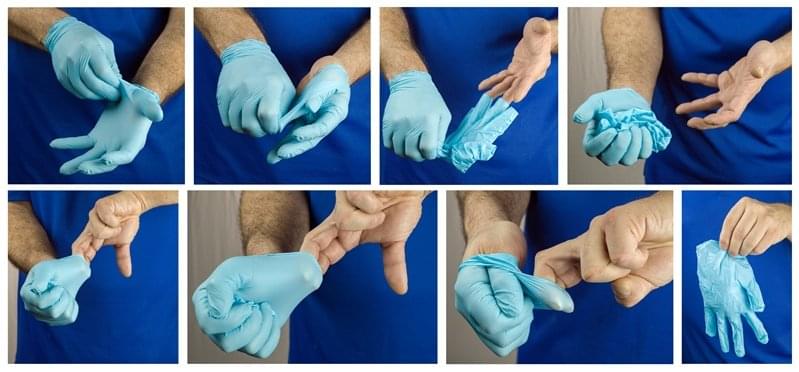When individuals put on a glove, they may not give any thought to how they go about this process, but there are specific steps wearers must take to ensure their gloves fit properly.
The key concern is creating a barrier between wearers’ skin and contaminants, pathogens or other hazardous materials. Nurses, for instance, need a barrier between themselves and patients’ blood, skin and contaminated surfaces. In the food service industry, gloves aid in keeping microscopic organisms from passing from staff hands to food stuffs and guard those same employees against health risks that come with handling uncooked meat, such as salmonella or other microbial foodborne illnesses.
However, if gloves are improperly donned, their ability to protect the users can be compromised. For this reason, wearers must take the appropriate steps when putting on gloves.
Here are the essential steps:
Finding the right size
Before gloves can be donned, the appropriate size must be found. Improperly sized gloves are more prone to tears, which can compromise the user’s safety. This applies to gloves that are too large or too small. A glove that is too tight can is more prone to punctures and tears and can reduce hand flexibility. A loose fit can lead to wrinkles, which can cause grip issues.
Users can determine if their gloves are too small by extending their fingers until straight. If the glove material appears to be stretching, the gloves are too small. Tears that occur where the thumb meets the palm also may indicate a glove is too small.
Putting gloves on
Once the proper size gloves are selected, wearers can put them on. The first step is to have a clean work area when donning gloves. Users don’t want to contaminate the gloves by placing them on a dirty surface. In an laboratory, for example, gloves should not be placed on a surface that has come into contact with harmful chemicals, as doing so can ultimately bring the wearer’s skin into contact with those chemicals.
In that same vein, all hand and wrist jewelry should be removed, and hands should be washed before gloves are worn. Dirty hands can contaminate the inside of the glove. This is because the hazardous materials and pathogens can be transferred from the unclean hands to the clean interior of the glove. In addition to protecting the wearer, this step can guard others who are going to come in contact with the wearer. Medical staff touch patients, so they don’t want pathogens or chemicals on their hands to contaminate the gloves.
Once work surfaces and hands are clean, users can begin to don the gloves. One key point is wearers should avoid touching the outside of the gloves as much as possible. First, the gloves can be placed on the prepared work surface. Then, the user puts a glove on his or her dominant hand by grabbing it with the other hand – remembering to only touch the inside of the glove – and slipping it over the dominant hand until it reaches finger level. Next, the wearer uses the gloved dominant hand to slip the other glove onto to the non-dominant hand.
Once both gloves are on, the users can touch the outside of the gloves to ensure a proper fit.
“Donning gloves properly is a quick best practice to implement.”
Addressing challenges of donning gloves
In some cases, users may find themselves unable to easily put their gloves on their hands. One key issue that can arise is the presence of moisture. If users do not have dry hands, they can experience difficulties donning their gloves.
One example comes from the automotive industry. If technicians are working in an auto shop on a particularly warm day, sweat may accumulate on their palms, and they may have trouble putting on gloves.
Powdered gloves may be the solution. Gloves that are powdered, with food grade corn starch, are designed to make it easier for users to don and doff. Users are cautioned to determine whether powdered gloves are appropriate for their application because the powder particles can decrease the integrity of certain automotive seals and contaminate some paints and finishes.
A powder-free alternative would be polymer-coated gloves which eliminates the need for powder and reduces surface tackiness.

These are the proper steps for doffing a glove.
Taking gloves off
There are also specific steps for removing gloves. In this case, users should never touch their skin with the outside of the glove to avoid contamination.
Using the dominant hand, users start by grabbing the outside of the glove on the non-dominant hand on the palm side near the cuff. Then, pull the glove off the non-dominant hand and place it in the gloved hand, balling it up. Next, slip two fingers under the cuff of the other glove and carefully peel it off the hand without touching the wrist, turning the remaining glove inside out as it is removed and in turn encasing the first glove. The gloves can then be disposed.






